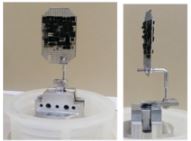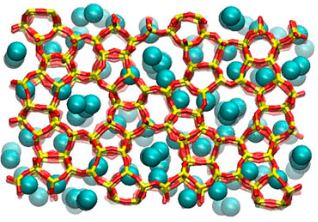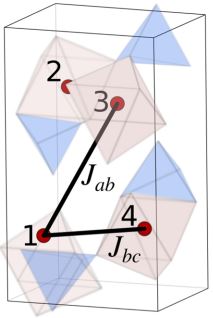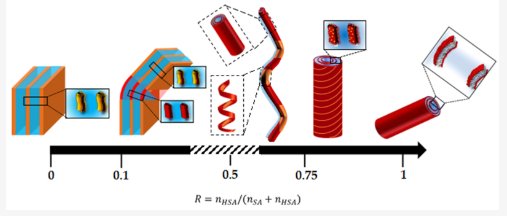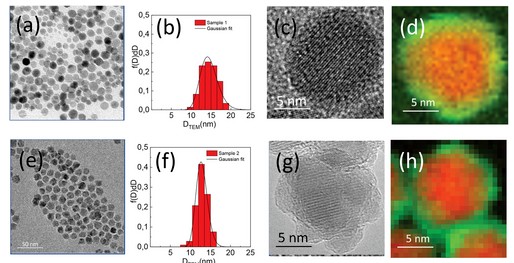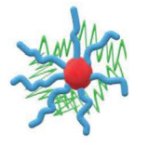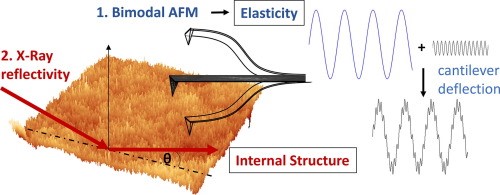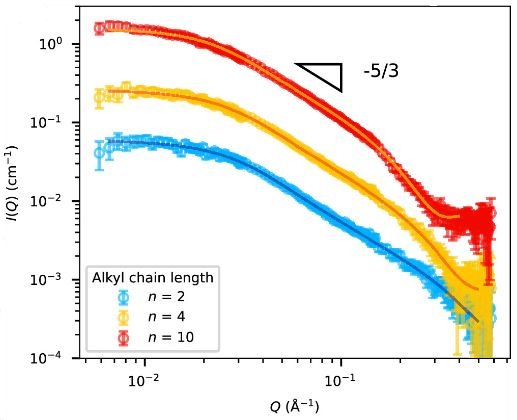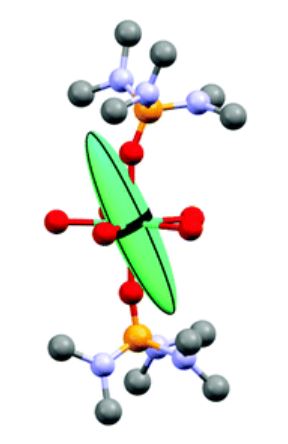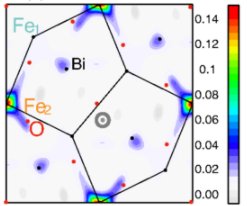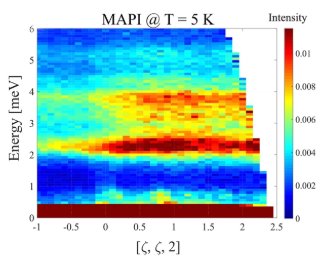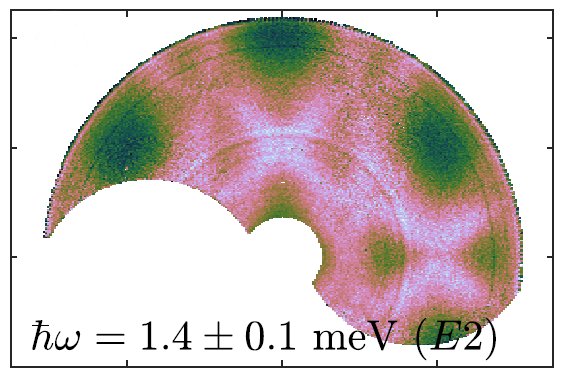Universality of q=1/2 orbital magnetism in the pseudogap phase of the high-Tc superconductor YBa2Cu3O6+x
Dalila Bounoua, Yvan Sidis, Martin Boehm, Paul Steffens, Toshinao Loew, Lin Shan Guo, Jun Qian, Xin Yao, and Philippe Bourges, Phys. Rev. B 108 (2023) 214408.
Several decades of debate have centered around the nature of the enigmatic pseudogap state in high-temperature superconducting copper oxides. Recently, we reported polarized neutron diffraction measurements that suggested the existence of a magnetic texture bound to the pseudogap phase [Bounoua et al. Commun. Phys. 5, 268 (2022)]. Such a magnetic texture is likely to involve the spontaneous appearance of loop currents within the CuO2 unit cells, which give birth to complex correlated patterns. In the underdoped YBa2Cu3O6.6, the magnetic structure factor of such an orbital magnetic texture gives rise to two distinct magnetic responses at q=0 and q=1/2. As this pattern alters the lattice translation invariance, such a state of matter could contribute to an instability of the Fermi surface. Here, we report polarized neutron scattering measurements on a nearly optimally doped high-quality single crystal of YBa2Cu3O6.9 that exhibits the same q=1/2 magnetism and a weakly overdoped YBa2Cu3O7 sample where this signal is no longer sizable. The in-plane and out-of-plane magnetic neutron scattering intensities in YBa2Cu3O6.9 (at q=1/2) and YBa2Cu3O6.85 (at q=0), reported previously, display the same temperature-dependent hallmarks. The magnitudes of both q=0 and q=1/2 magnetic signals further exhibit the same trends upon doping in YBa2Cu3O6+x, confirming that they are likely intertwined.
On De Gennes narrowing of fluids confined at the molecular scale in nanoporous materials
Wanda Kellouai, Jean-Louis Barrat, Patrick Judeinstein, Marie Plazanet, Benoit Coasne, J. Chem. Phys. 160, 024113 (2024).
Beyond well-documented confinement and surface effects arising from the large internal surface and severely confining porosity of nanoporous hosts, the transport of nanoconfined fluids remains puzzling in many aspects. With striking examples such as memory, i.e., non-viscous effects, intermittent dynamics, and surface barriers, the dynamics of fluids in nanoconfinement challenge classical formalisms (e.g., random walk, viscous/advective transport)—especially for molecular pore sizes. In this context, while molecular frameworks such as intermittent Brownian motion, free volume theory, and surface diffusion are available to describe the self-diffusion of a molecularly confined fluid, a microscopic theory for collective diffusion (i.e., permeability), which characterizes the flow induced by a thermodynamic gradient, is lacking. Here, to fill this knowledge gap, we invoke the concept of “De Gennes narrowing,” which relates the wavevector-dependent collective diffusivity D0(q) to the fluid structure factor S(q). First, using molecular simulation for a simple yet representative fluid confined in a prototypical solid (zeolite), we unravel an essential coupling between the wavevector-dependent collective diffusivity and the structural ordering imposed on the fluid by the crystalline nanoporous host. Second, despite this complex interplay with marked Bragg peaks in the fluid structure, the fluid collective dynamics is shown to be accurately described through De Gennes narrowing. Moreover, in contrast to the bulk fluid, the departure from De Gennes narrowing for the confined fluid in the macroscopic limit remains small as the fluid/solid interactions in severe confinement screen collective effects and, hence, weaken the wavevector dependence of collective transport.
Ellen Fogh, Bastian Klemke, Manfred Reehuis, Philippe Bourges, Christof Niedermayer, Sonja Holm-Dahlin, Oksana Zaharko, Jürg Schefer, Andreas B. Kristensen, Michael K. Sørensen, Sebastian Paeckel, Kasper S. Pedersen, Rasmus E. Hansen, Alexandre Pages, Kimmie K. Moerner, Giulia Meucci, Jian-Rui Soh, Alessandro Bombardi, David Vaknin, Henrik. M. Rønnow, Olav F. Syljuåsen, Niels B. Christensen and Rasmus Toft-Petersen
Control of magnetization and electric polarization is attractive in relation to tailoring materials for data storage and devices such as sensors or antennae. In magnetoelectric materials, these degrees of freedom are closely coupled, allowing polarization to be controlled by a magnetic field, and magnetization by an electric field, but the magnitude of the effect remains a challenge in the case of single-phase magnetoelectrics for applications. We demonstrate that the magnetoelectric properties of the mixed-anisotropy antiferromagnet LiNi1−xFexPO4 are profoundly affected by partial substitution of Ni2+ ions with Fe2+ on the transition metal site. This introduces random site-dependent single-ion anisotropy energies and causes a lowering of the magnetic symmetry of the system. In turn, magnetoelectric couplings that are symmetry-forbidden in the parent compounds, LiNiPO4 and LiFePO4, are unlocked and the dominant coupling is enhanced by almost two orders of magnitude. Our results demonstrate the potential of mixed-anisotropy magnets for tuning magnetoelectric properties.
Maëva Almeida, Daniel Dudzinski, Catherine Amiel, Jean-Michel Guigner,Sylvain Prévost, Clémence Le Coeur and Fabrice Cousin
Here, we describe the behavior of mixtures of stearic acid (SA) and its hydroxylated counterpart 12-hydroxystearic acid (12-HSA) in aqueous mixtures at room temperature as a function of the 12-HSA/SA mole ratio R. The morphologies of the self-assembled aggregates are obtained through a multi-structural approach that combines confocal and cryo-TEM microscopies with small-angle neutron scattering (SANS) and wide-angle X-ray scattering (WAXS) measurements, coupled with rheology measurements. Fatty acids are solubilized by an excess of ethanolamine counterions, so that their heads are negatively charged. A clear trend towards partitioning between the two types of fatty acids is observed, presumably driven by the favorable formation of a H-bond network between hydroxyl OH function on the 12th carbon. For all R, the self-assembled structures are locally lamellar, with bilayers composed of crystallized and strongly interdigitated fatty acids. At high R, multilamellar tubes are formed. The doping via a low amount of SA molecules slightly modifies the dimensions of the tubes and decreases the bilayer rigidity. The solutions have a gel-like behavior. At intermediate R, tubes coexist in solution with helical ribbons. At low R, local partitioning also occurs, and the architecture of the self-assemblies associates the two morphologies of the pure fatty acids systems: they are faceted objects with planar domains enriched in SA molecules, capped with curved domains enriched in 12-HSA molecules. The rigidity of the bilayers is strongly increased, as well their storage modulus. The solutions remain, however, viscous fluids in this regime.
I. V. Golosovsky, I. A. Kibalin, A. Gukasov, A. G. Roca, A. López-Ortega, M. Estrader, M. Vasilakaki, K. N. Trohidou, T. C. Hansen, I. Puente-Orench, E. Lelièvre-Berna, J. Nogués
Heterogeneous bi-magnetic nanostructured systems have had a sustained interest during the last decades owing to their unique magnetic properties and the wide range of derived potential applications. However, elucidating the details of their magnetic properties can be rather complex. Here, a comprehensive study of Fe3O4/Mn3O4 core/shell nanoparticles using polarized neutron powder diffraction, which allows disentangling the magnetic contributions of each of the components, is presented. The results show that while at low fields the Fe3O4 and Mn3O4 magnetic moments averaged over the unit cell are antiferromagnetically coupled, at high fields, they orient parallel to each other. This magnetic reorientation of the Mn3O4 shell moments is associated with a gradual evolution with the applied field of the local magnetic susceptibility from anisotropic to isotropic. Additionally, the magnetic coherence length of the Fe3O4 cores shows some unusual field dependence due to the competition between the antiferromagnetic interface interaction and the Zeeman energies. The results demonstrate the great potential of the quantitative analysis of polarized neutron powder diffraction for the study of complex multiphase magnetic materials.
https://doi.org/10.1002/smtd.202201725
Özge Azeri, Dennis Schönfeld, Bin Dai, Uwe Keiderling, Laurence Noirez and Michael Gradzielski
Block copolymers synthesized via Atom Transfer Radical Polymerization from alkyl acrylate and t-butyl acrylate and the subsequent hydrolysis of the t-butyl acrylate to acrylic acid were systematically varied with respect to their hydrophobic part by the variation in the alkyl chain length and the degree of polymerisation in this block. Depending on the architecture of the hydrophobic part, they had a more or less pronounced tendency to form copolymer micelles in an aqueous solution. They were employed for the preparation of IPECs by mixing the copolymer aggregates with the polycations polydiallyldimethylammonium chloride (PDADMAC) or q-chit. The IPEC structure as a function of the composition was investigated by Static Light and Small Angle Neutron Scattering. For weakly-associated block copolymers (short alkyl chain), complexation with polycation led to the formation of globular complexes, while already existing micelles (long alkyl chain) grew further in mass. In general, aggregates became larger upon the addition of further polycation, but this growth was much more pronounced for PDADMAC compared to q-chit, thereby leading to the formation of clusters of aggregates. Accordingly, the structure of such IPECs with a hydrophobic block depended largely on the type of complexing polyelectrolyte, which allowed for controlling the structural organisation via the molecular architecture of the two oppositely charged polyelectrolytes.
Michal Swierczewski, Alexis Chenneviere, Lay-Theng Lee, Plinio Maroni, Thomas Bürgi
Langmuir-Blodgett (LB) technique allows the deposition of gold nanoclusters (atomically precise nanoparticles below 2 nm in diameter) onto solid substrates with an unprecedented degree of control and high transfer ratios. Nanoclusters are expected to follow the crinkle folding mechanism, which promotes the formation of trilayers but kinetically disfavors the formation of the fourth layer. LB films of gold nanoclusters stabilized by thiolated ligand, Au38(SC2H4Ph)24, were prepared at a range of surface pressures in the bilayer/trilayer regime and their internal structure was analyzed with X-ray Reflectivity (XRR) and Grazing-Incidence Wide-Angle X-ray Scattering (GIWAXS). Bimodal atomic force microscopy (AFM) imaging was used to quantify the elastic modulus, which can be correlated with the topography at the same point on the surface. Nanocluster bilayers and trilayers exhibited the elastic moduli of ca. 1.2 GPa and 0.9 GPa respectively. Films transferred in the 20-25 mN/m surface pressure regime displayed a particular propensity to form highly vertically organized trilayers. Further compression resulted in disorganization of the layers. Crucially, the use of two cantilevers of contrasting stiffness for bimodal AFM measurements has demonstrated a new approach to quantify the mechanical properties of ultrathin films without the use of deconvolution algorithms to remove the substrate contribution.
Tiago Outerelo Corvo, Antoine Jourdain, Shona O’Brien, Frédéric Restagno, Eric Drockenmuller, and Alexis Chennevière
Poly(ionic liquid)s (PILs), similar to their ionic liquid (IL) analogues, present a nanostructure arising from local interactions. The influence of this nanostructure on the macromolecular conformation of polymer chains is investigated for the first time by means of an extensive use of small-angle neutron scattering on a series of poly(1-vinyl-3-alkylimidazolium)s with varying alkyl side-chain length and counter-anion, both in bulk and in dilute solutions. Radii of gyration are found to increase with the side-chain length in solution as a consequence of crowding interactions between neighboring monomers. In bulk, however, a nonmonotonic evolution of the radius of gyration reflects a change in chain flexibility and a potential screening of electrostatic interactions. Additionally, at a smaller scale, SANS provides an experimental estimation of both the chain diameter and the correlation length between neighboring chains, comparison of which unveils clear evidence of interdigitation of the alkyl side chains. These structural features bring precious insights into the understanding of the dynamic properties of PILs.
Emil A. Klahn, Andreas M. Thiel, Rasmus B. Degn, Iurii Kibalin, Arsen Gukassov, Claire Wilson, Angelos B. Canaj, Mark Murrie and Jacob Overgaard
We present the magnetic anisotropy of two isostructural pentagonal-bipyramidal complexes, [Ln(H2O)5(HMPA)2]I3·2HMPA (HMPA = hexamethylphosphoramide, Ln = Dy, Ho). Using ac magnetic susceptibility measurements, we find magnetic relaxation barriers of 600 K and 270 K for the Dy- and Ho-compounds, respectively. This difference is supported by polarized neutron diffraction (PND) measured at 5 K and 1 T which provides the first experimental evidence that the transverse elements in the magnetic anisotropy of the Ho-analogue are significant, whereas the Dy-analogue has a near-axial magnetic anisotropy with vanishing transverse contributions. The coordination geometries of the two complexes are highly similar, and we attribute the loss of strong magnetic axiality as expressed in the atomic susceptibility tensors from PND, as well as the smaller relaxation barrier in the Ho-complex compared to the Dy-complex, to the less favorable interaction of the pentagonal bipyramidal crystal field with the characteristics of the Ho(III) 4f-charge distribution.
Dalila Bounoua, Lucile Mangin-Thro, Jaehong Jeong, Romuald Saint-Martin, Loreynne Pinsard-Gaudart, Yvan Sidis & Philippe Bourges, Communications Physics 3, (2020) 123.
New phases with broken discrete Ising symmetries are uncovered in quantum materials with strong electronic correlations. The two-leg ladder cuprate Sr14−xCaxCu24O41 hosts a very rich phase diagram where, upon hole doping, the system exhibits a spin liquid state ending to an intriguing ordered magnetic state at larger Ca content.
Using polarized neutron diffraction, we report here the existence of short range magnetism in this material for two Ca contents, whose origin cannot be ascribed to Cu spins. This magnetism develops exclusively within the two-leg ladders with a diffraction pattern at forbidden Bragg scattering, which is the hallmark of loop current-like magnetism breaking both time-reversal and parity symmetries.
Our discovery shows local discrete symmetry breaking in a one dimensional spin liquid system as theoretically predicted. It further suggests that a loop current-like phase could trigger the long range magnetic order reported at larger doping in two-leg ladder cuprates.
K. Beauvois, V. Simonet, S. Petit, J. Robert, F. Bourdarot, M. Gospodinov, A.A. Mukhin, R. Ballou, V. Skumryev, and E. Ressouche
The research field of magnetic frustration is dominated by triangle-based lattices but exotic phenomena can also be observed in pentagonal networks. A peculiar noncollinear magnetic order is indeed known to be stabilized in Bi2Fe4O9 materializing a Cairo pentagonal lattice. We present the spin wave excitations in the magnetically ordered state, obtained by inelastic neutron scattering. They reveal an unconventional excited state related to local precession of pairs of spins. The magnetic excitations are then modeled to determine the superexchange interactions for which the frustration is indeed at the origin of the spin arrangement. This analysis unveils a hierarchy in the interactions, leading to a paramagnetic state (close to the Néel temperature) constituted of strongly coupled dimers separated by much less correlated spins. This produces two types of response to an applied magnetic field associated with the two nonequivalent Fe sites, as observed in the magnetization distributions obtained using polarized neutrons.
A. C. Ferreira, S. Paofai, A. Létoublon, J. Ollivier, S. Raymond, B. Hehlen, B. Rufflé, S. Cordier, C. Katan, J. Even & P. Bourges
Hybrid organolead perovskites (HOP) have started to establish themselves in the field of photovoltaics, mainly due to their great optoelectronic properties and steadily improving solar cell efficiency. Study of the lattice dynamics is key in understanding the electron-phonon interactions at play, responsible for such properties. Here, we investigate, via neutron and Raman spectroscopies, the optical phonon spectrum of four different HOP single crystals: MAPbBr3, FAPbBr3, MAPbI3, and α-FAPbI3. Low temperature spectra reveal weakly dispersive optical phonons, at energies as low as 2-5 meV, which seem to be the origin of the limit of the charge carriers mobilities in these materials. The temperature dependence of our neutron spectra shows as well a significant anharmonic behaviour, resulting in optical phonon overdamping at temperatures as low as 80 K, questionning the validity of the quasi-particle picture for the low energy optical modes at room temperature where the solar cells operate.
M. Ruminy, S. Guitteny, J. Robert, L.-P. Regnault, M. Boehm, P. Steffens, H. Mutka, J. Ollivier, U. Stuhr, J. S. White, B. Roessli, L. Bovo, C. Decorse, M. K. Haas, R. J. Cava, I. Mirebeau, M. Kenzelmann, S. Petit, and T. Fennell
Tb2Ti2O7 presents an ongoing conundrum in the study of rare-earth pyrochlores. Despite the expectation that it should be the prototypical unfrustrated noncollinear Ising antiferromagnet on the pyrochlore lattice, it presents a puzzling correlated state that persists to the lowest temperatures. Effects which can reintroduce frustration or fluctuations are therefore sought, and quadrupolar operators have been implicated. One consequence of strong quadrupolar effects is the possible coupling of magnetic and lattice degrees of freedom, and it has previously been shown that a hybrid magnetoelastic mode with both magnetic and phononic character is formed in Tb2Ti2O7 by the interaction of a crystal field excitation with a transverse-acoustic phonon. Here, using polarized and unpolarized inelastic neutron scattering, we present a detailed characterization of the magnetic and phononic branches of this magnetoelastic mode, particularly with respect to their composition, the anisotropy of any magnetic fluctuations, and also the temperature dependence of the different types of fluctuation that are involved. We also examine the dispersion relations of the exciton branches that develop from the crystal field excitation in the same temperature regime that the coupled mode appears, and find three quasidispersionless branches where four are expected, each with a distinctive structure factor indicating that they are nonetheless cooperative excitations. We interpret the overall structure of the spectrum as containing four branches, one hybridized with the phonons and gaining a strong dispersion, and three remaining dispersionless.
Béatrice Gillon, Albert Hammerschmied, Arsen Gukasov, Alain Cousson, Thomas Cauchy, Eliseo Ruiz, John A. Schlueter, Jamie L. Manson
We report neutron‐diffraction investigations of the quasi‐2D MnII(dca)2(pym)(H2O) (pym = N2C4H4) compound, where high‐spin MnII ions are bridged by dicyanamide anions, [N(CN)2]– (herein abbreviated dca). Inside the layers, Mn2+ ions are connected by single or double dca bridges. The magnetic phase diagram was established by neutron diffraction on a single crystal. In the low‐field phase, the MnII ions are antiferromagnetically ordered in the layers, with moments nearly parallel to the c axis, and the layers are antiferromagnetically coupled. The spin‐flop phase corresponds to ferromagnetic coupling between the antiferromagnetic layers, in which the MnII moments are nearly perpendicular to the c axis. The induced spin‐density distribution in the paramagnetic phase, determined by polarized neutron diffraction, visualizes the superexchange pathways through the dca ligands within the layers and through H bonding between neighboring layers. The theoretical spin density obtained by bidimensional periodic DFT calculations is compared with the experimental results. Furthermore, quantum Monte Carlo simulations have been performed to compare the DFT results with experimental susceptibility measurements.
L. Pinsard-Godard, Laboratoire de Chimie du Solide, Paris XI
A. Ivanov, ILL, BP 156 F-38042 Grenoble
Multi-ferroïcs are exceptional materials whose fundamental state is both magnetic and ferro-electric [1]. Moreover, in such materials, magnetism and ferroelectricity maintains close links: as for example the manganese oxide YMnO3 [2], can see its magnetization modified by the action of an electric field, or its electric polarization by the action of a magnetic field (magnetoelectric effect). Muli-ferroïcity is a complex problem in physics of condensed matter; it also represents an important stake for the applications, and for example for “technologies for the information and health” developed at the CEA (development of new concepts of memorizing the information or spin electronics).
The last research on these materials tends to show that the coupling between magnetism and ferro-electricity occurs via important deformations of the crystal lattice. It is known for example that in the case of the compound YMnO3, the transition (TN = 72K) towards the magnetic phase (and thus multi-ferroïc) is the seat of magnetostrictive effects that reveals the strong coupling between atomic displacements, magnetic ferroelectricity and moments.









 Physics, chemistry, nanoscience and materials around large instruments
Physics, chemistry, nanoscience and materials around large instruments